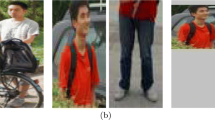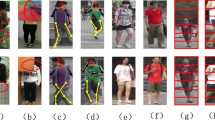Abstract
Background clutters and pose variation are the key factors which prevents the network from learning a robust Person re-identification (Re-ID) model. To address the problem above, we first introduce the binary segmentation mask to construct the body region served as the input of the generator, then design a segmentation mask-guided person image generation network for the pose transfer. The binary segmentation mask has the capability of removing the background clutters in pixel-level, and contains more details about the edge information, where better shape consistency can be achieved for the generated image with the input image. Compared with the previous methods, the proposed method can dramatically improve the model adaptive ability and deal with the diversity of postures. In addition, we design a lightweight attention mechanism module as a guider module, which can assist the generator to focus on the discriminative features of pedestrians. The experiment results are introduced to demonstrate the effectiveness of the proposed method and the superiority performance over most state-of-the-art methods without over-computing in the design process of the Re-ID model. It is worth mentioning that our ideas can be easily combined with other fields to solve the phenomenon of the current situation with insufficient pose variations in the datasets.











Similar content being viewed by others
References
Liu Z, Li D, Ge SS, and Tian F (2019) Small traffic sign detection from large image. Appl Intel pp 1–13
Li X, Zheng WS, Wang X, Xiang T, Gong S (2015) Multi-scale learning for low-resolution person re-identification. In: CVPR, pp. 3765–3773
Tao D, Jin L, Wang Y, Yuan Y, Li X (2013) Person re-identification by regularized smoothing kiss metric learning. IEEE Trans Circ Syst Video Technol 23(10):1675–1685
Zhang R, Lin L, Zhang R, Zuo W, Zhang L (2015) Bit-scalable deep hashing with regularized similarity learning for image retrieval and person re-identification. IEEE Trans Image Process 24(12):4766–4779
Zheng WS, Gong S, Xiang T (2012) Reidentification by relative distance comparison. IEEE Trans Pattern Anal Mach Intell 35(3):653–668
Wang T, Gong S, Zhu X, Wang S (2016) Person re-identification by discriminative selection in video ranking. IEEE Trans Pattern Anal Mach Intell 38(12):2501–2514
Chen YC, Zhu X, Zheng WS, Lai JH (2017) Person re-identification by camera correlation aware feature augmentation. IEEE Trans Pattern Anal Mach Intell 40(2):392–408
Protopapadakis E, Voulodimos A, Doulamis A, Doulamis N, Stathaki T (2019) Automatic crack detection for tunnel inspection using deep learning and heuristic image post-processing. Appl Intell 49(7):2793–2806
Song Y, Lee JW, Lee J (2019) A study on novel filtering and relationship between input-features and target-vectors in a deep learning model for stock price prediction. Appl Intell 49(3):897–911
Acharya UR, Fujita H, Oh SL, Hagiwara Y, Tan JH, Adam M, San Tan R (2019) Deep convolutional neural network for the automated diagnosis of congestive heart failure using ecg signals. Appl Intell 49(1):16–27
Ma L, Sun Q, Georgoulis S, Van Gool L, Schiele B, Fritz M (2018) Disentangled person image generation. In CVPR, pp 99–108
Pumarola A, Agudo A, Sanfeliu A, Moreno-Noguer F (2018) Unsupervised person image synthesis in arbitrary poses. In CVPR, pp 8620–8628
Gatys LA, Ecker AS, Bethge M (2016) Image style transfer using convolutional neural networks. In CVPR, pp 2414–2423
Liu J, Sun C, Xu X, Xu B, Yu S (2019) A spatial and temporal features mixture model with body parts for video-based person re-identification. Appl Intell 49(9):3436–3446
Li W, Zhu X, Gong S (2018) Harmonious attention network for person re-identification. In CVPR, pp 2285–2294
Chang X, Hospedales TM, Xiang T (2018) Multi-level factorisation net for person re-identification. In CVPR, pp 2109–2118
Li W, Zhao R, Xiao T, Wang X (2014) Deepreid: deep filter pairing neural network for person re-identification. In CVPR, pp 152–159
Zhu Z, Huang T, Shi B, Yu M, Wang B, Bai X (2019) Progressive pose attention transfer for person image generation. In CVPR, pp 2347–2356
Liu J, Ni B, Yan Y, Zhou P, Cheng S, Hu J (2018) Pose transferrable person re-identification. In CVPR, pp 4099–4108
Ma L, Jia X, Sun Q, Schiele B, Tuytelaars T, Van Gool L (2017) Pose guided person image generation. Advances in Neural Information Processing Systems. pp 406–416
Tang H, Zhao Y, Lu H (2019) Unsupervised person re-identification with iterative self-supervised domain adaptation. In CVPR
Su C, Li J, Zhang S, Xing J, Gao W, Tian Q (2017) Pose-driven deep convolutional model for person re-identification. In CVPR, pp 3960–3969
Zheng Z, Yang X, Yu Z, Zheng L, Yang Y, Kautz J (2019) Joint discriminative and generative learning for person re-identification. In CVPR, pp 2138–2147
Siarohin A, Sangineto E, Lathuilière S, Sebe N (2018) Deformable gans for pose-based human image generation. In CVPR, pp 3408–3416
Wang L, Tan T, Ning H, Hu W (2003) Silhouette analysis-based gait recognition for human identification. IEEE Trans Pattern Anal Mach Intell 25(12):1505–1518
Zhong Z, Zheng L, Zheng Z, Li S, Yang Y (2018) Camera style adaptation for person re-identification. In CVPR, pp 5157–5166
Zhu JY, Park T, Isola P, Efros AA (2017) Unpaired image-to-image translation using cycle-consistent adversarial networks. In ICCV, pp 2223–2232
Wei L, Zhang S, Gao W, Tian Q (2018) Person transfer Gan to bridge domain gap for person re-identification. In CVPR, pp 79–88
Zhong Z, Zheng L, Li S, Yang Y (2018) Generalizing a person retrieval model hetero-and homogeneously. In ECCV, pp 172–188
Choi Y, Choi M, Kim M, Ha J-W, Kim S, Choo J (2018) Stargan: Unified generative adversarial networks for multi-domain image-to-image translation. In CVPR, pp 8789–8797
Bak S, Carr P, Lalonde JF (2018) Domain adaptation through synthesis for unsupervised person re-identification. In ECCV, pp 189–205
Song S, Zhang W, Liu J, Mei T (2019) Unsupervised person image generation with semantic parsing transformation. In CVPR, pp 2357–2366
Woo S, Park J, Lee JY, So Kweon I (2018) Cbam: convolutional block attention module. In ECCV, pp 3–19
Hou S, Wang Z (2019) Weighted channel dropout for regularization of deep convolutional neural network. In AAAI, pp 8425–8432
Song C, Huang Y, Ouyang W, Wang L (2018) Mask-guided contrastive attention model for person re-identification. In CVPR, pp 1179–1188
He K, Zhang X, Ren S, Sun J (2016) Deep residual learning for image recognition. In CVPR, pp 770–778
Wei SE, Ramakrishna V, Kanade T, Sheikh Y (2016) Convolutional pose machines. In CVPR, pp 4724–4732
Radford A, Metz L, Chintala S (2015) Unsupervised representation learning with deep convolutional generative adversarial networks. arXiv:1511.06434
Efraimidis PS, Spirakis PG (2006) Weighted random sampling with a reservoir. Inf Process Lett 97(5):181–185
Tompson J, Goroshin R, Jain A, LeCun Y, Bregler C (2015) Efficient object localization using convolutional networks. In CVPR, pp 648–656
Liao S, Hu Y, Zhu X, Li SZ (2015) Person re-identification by local maximal occurrence representation and metric learning. In CVPR, pp 2197–2206
Zheng L, Yang Y, Hauptmann AG (2016) Person re-identification: Past, present and future. arXiv:1610.02984
Zheng Z, Zheng L, Yang Y (2017) Unlabeled samples generated by gan improve the person re-identification baseline in vitro. In CVPR, pp 3754–3762
Qian X, Fu Y, Xiang T, W. Wang, J. Qiu, Y. Wu, Y.G. Jiang, and Xue X (2018) Pose-normalized image generation for person re-identification. In ECCV, pp 650–667
Zheng Z, Zheng L, Yang Y (2018) Pedestrian alignment network for large-scale person re-identification. IEEE Trans Circ Syst Video Technol 29(10):3037–3045
Wang G, Yuan Y, Chen X, Li J, Zhou X (2018) Learning discriminative features with multiple granularities for person re-identification. In ACM pp 274–282
Wang Y, Chen Z, Wu F, Wang G (2018) Person re-identification with cascaded pairwise convolutions. In CVPR, pp 1470–1478
Lin Y, Zheng L, Zheng Z, Wu Y, Hu Z, Yan C, Yang Y (2019) Improving person re-identification by attribute and identity learning. 95:151–161
Yang Q, Yu HX, Wu A, Zheng WS (2019) Patch-based discriminative feature learning for unsupervised person re-identification. In CVPR, pp 3633–3642
Zhang C, Wu L, Wang Y (2019) Crossing generative adversarial networks for cross-view person re-identification. Neurocomputing. 340:259–269
Li M, Zhu X, Gong S (2019) Unsupervised tracklet person re-identification. IEEE Trans Pattern Anal Mach Intell 42(7):1770–1782. https://doi.org/10.1109/TPAMI.2019.2903058
Chung D, Delp EJ (2019) Camera-aware image-to-image translation using similarity preserving stargan for person re-identification. In CVPR
Zhong Z, Zheng L, Zheng Z, Li S, Yang Y (2019) Camstyle: a novel data augmentation method for person re-identification. IEEE Trans Image Process 28(3):1176–1190
Acknowledgements
The work is supported by National Natural Science Foundation of China (61573114) and Fundamental Research Funds for the Central Universities (HEUCF160415). This work is also supported by College of Intelligent Systems Science and Engineering, Harbin Engineering University.
Author information
Authors and Affiliations
Corresponding authors
Additional information
Publisher’s note
Springer Nature remains neutral with regard to jurisdictional claims in published maps and institutional affiliations.
Rights and permissions
About this article
Cite this article
Liu, M., Yan, X., Wang, C. et al. Segmentation mask-guided person image generation. Appl Intell 51, 1161–1176 (2021). https://doi.org/10.1007/s10489-020-01907-w
Published:
Issue Date:
DOI: https://doi.org/10.1007/s10489-020-01907-w




